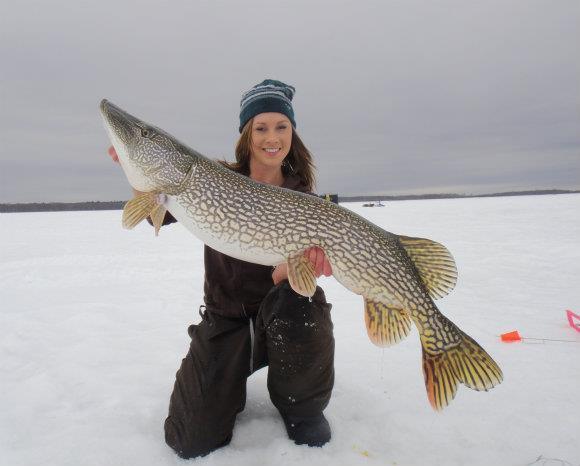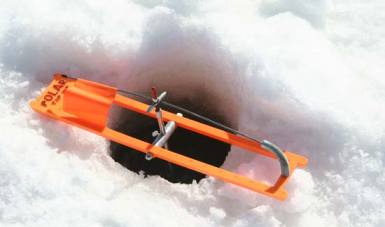Fishing is a year-round pursuit and for anglers who can’t get enough. That means a big shift in gears this time of year. There’s very little open water in Michigan in winter and if you want to get into the wet stuff, that usually means you have to cut a hole in the hard stuff first.
Ice fishing ranges from pastime to passion; for some anglers, it’s more enjoyable than fishing in the summer. And it has its advantages. Anglers who don’t have boats, for instance, can get just about anywhere on the lake when there’s a foot of ice covering it.
Ice fishermen can pursue almost every fish they chase in open-water season, with the exception of bass (the season closes Jan. 1). But pike, walleye, and all species of panfish are open and anglers can fish for trout in select waters. There are even some opportunities – sturgeon on Black Lake, for instance, that are allocated to ice anglers.
Fishermen need three basic tools to get started ice fishing: something to make a hole in the ice, something to clear the hole and keep it open, and something to fish with.
Two basic tools are used to open a hole in the ice spuds and augers. Spuds look like metal spears with chisel-like heads. Anglers use spuds to chip open a hole. Augers, on the other hand, look like cork screws with cutting blades along the edges. There are both power and hand operated augers.
A skimmer or slush scoop, which looks like a perforated ladle, is used to clean the hole and keep it open.
Anglers can use spears for some species. It’s best to spear from inside a shanty. Not only does it provide shelter, it also blocks the light, making it easier to see into the water.
As for fishing gear, anglers are generally limited only by their imaginations. Most popular are short rods with spinning reels, though some folks prefer simple poles with spring tension spools that are used basically as line
Starting on the ice is not expensive. The basic ice fishing equipment tools are a rod / reel combination, drill, bucket with a seat, jigs and bait. Adding portable ice fishing shelters to your gear, especially after the first few times if the decision has been made to stay in the sport.
A spinning combination with 24″ light action rod. The Frabill 24″ Ultra Light Panfish Popper Plus Ice Combo for its ease of use and spring bobber. If budget allows, purchase two combinations. The reels are ultra lights, which can also be used during open water times of the year.
Next, comes a drill. This tool is essential, and a hand model may be preferred at the beginning, mainly because of cost. If you think you’ll stick the sport,a power drill may be considered to drill your holes.
Another essential of the sport is a stool to sit on while you’re out on the ice. Frabill has a combination of bucket and seat called a Sit-N-Fish, which also has an area for bait and tackle. This multi-functional product has a padded foam snap – on seat lid and beverage holders on inner bucket lid.
When it comes to ice fishing jigs,sticking to the basics. Custom Jigs & Spins is one of the most popular and productive products in ice fishing tackle. The assortments he uses are the glow colors in the Ratso, Rat Finkee and Demon models, in sizes of 12 through 8.
Wax worms are a good all around bait, but make sure to have spikes, wigglers and perch minnows
One-man portable ice shanty is an excellent choice for any ice angler, no matter what level of experience. For a few more dollars, 2 to 3 man ice shelters can be purchased which will give room for a buddy, as well as extra equipment. More tips on choosing an ice shelter can be found here: http://www.farmandfleet.com/services/articles/article_ice_shelter.asp
x
Ice fishing safety is very important, so be sure to have the proper warm clothing, including a good pair of gloves. Frostbite and hypothermia can be a serious problem for ice anglers. Wear thick gear like a Carhartt jacket and flannel lined jeans.
Another product for safety on the lake is a set of ice picks that are worn around the neck on a cord. Hopefully a person will never have to use this device, but if they fall through the ice, it is the easiest way, other than having a rope thrown out by another person, to pull out of the hole.
The U.S. Army recommends a minimum thickness of two inches of ice for a 200-pound load. Avoid areas where the ice is discolored, where vegetation or timber protrude through the ice, or where there is an inlet or outlet – moving water, from a creek or springs, can weaken ice.
Ice safety experts recommend that anglers wear a personal floatation device and carry a rope so they can reach someone in trouble without approaching them too closely. Simple ice picks can help someone who falls in gain hold on the ice to pull themselves back out.
Some anglers prefer to use tip-ups like this one. Tip-ups sit on the ice above the hole and dangle the bait in the water. They feature small reels that are submerged beneath the ice and a spring-loaded flag that’s bent down and attached to the reel. When a fish bites, the flag tips up.
Ice fishing can be fun and productive, but it isn’t worth taking unnecessary risks. Always pay attention to the direction of the wind, especially on large bodies of water, as ice can break off and drift away.
Should you fall, try not to panic. The first order of business is to get out. Always turn toward the direction you approached, where you last had good ice, and try to slide out. Once you’re back on the ice, do not try to get up until you know you are on good ice. Crawl or roll away from the hole.
As with everything, remember, safety first. Make sure the ice thickness is good (at least 3 to 4 inches). Check the ice fishing reports in your area. If possible go with a buddy, or where there is a group of other ice anglers close by. Even experienced ice fisherman can find themselves in some tricky situations if they let their guard down.
Northern Pike Ice Fishing
So you found them, huh. Well how do we catch em? The most common way to ice fish for Northern Pike is by using Tip-ups. This ice fishing contraption is simple and effective.
Tip Up for Pike Fishing
More Northern Pike have probably been caught using a plain hook and a sucker minnow on a Tip-up then any other method.
Live bait is the only good option to be used with Tip-Ups. Generally the bigger the Pike you’re after the larger the minnow you’ll want to use. Generally a 3-6 inch minnow is used in NY, but if you’re in Canada or New England a 6-8 inch minnow is more common because the Pike are usually larger. We recommend adding two brightly colored red beads to the line and leader to make it even easier for the Pike to see.
You can catch Northern Pike while ice fishing for any fish, however, because they’re known to eat almost anything. Even small jigs with meal worms may catch a Pike or two.


